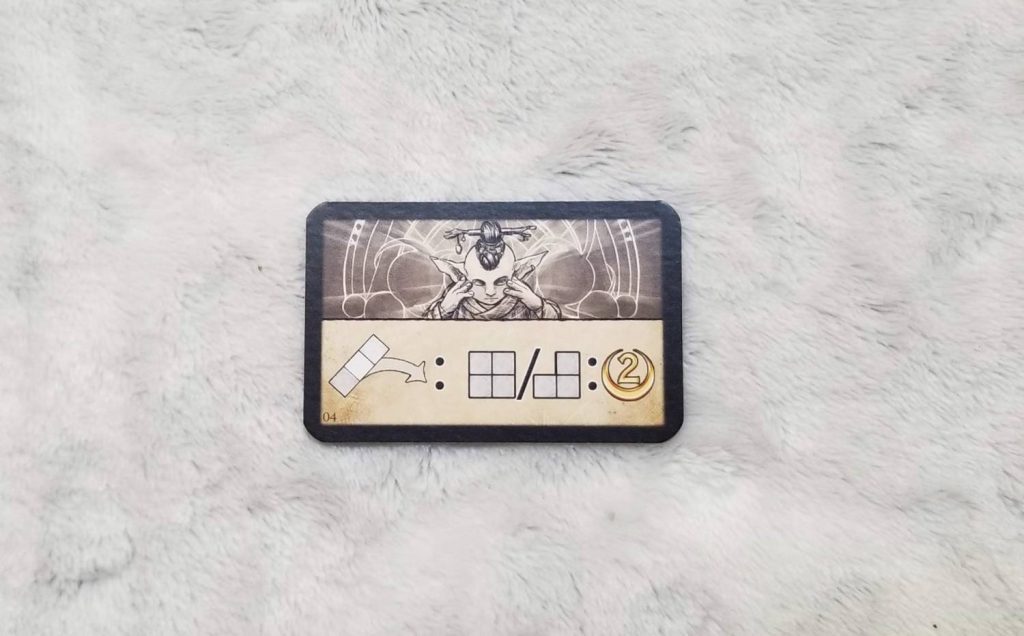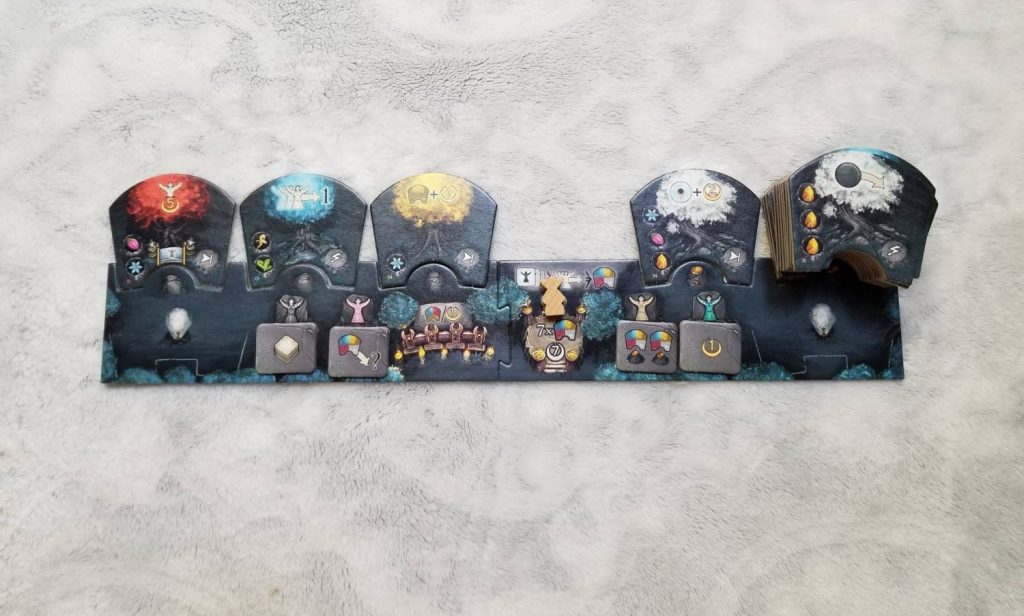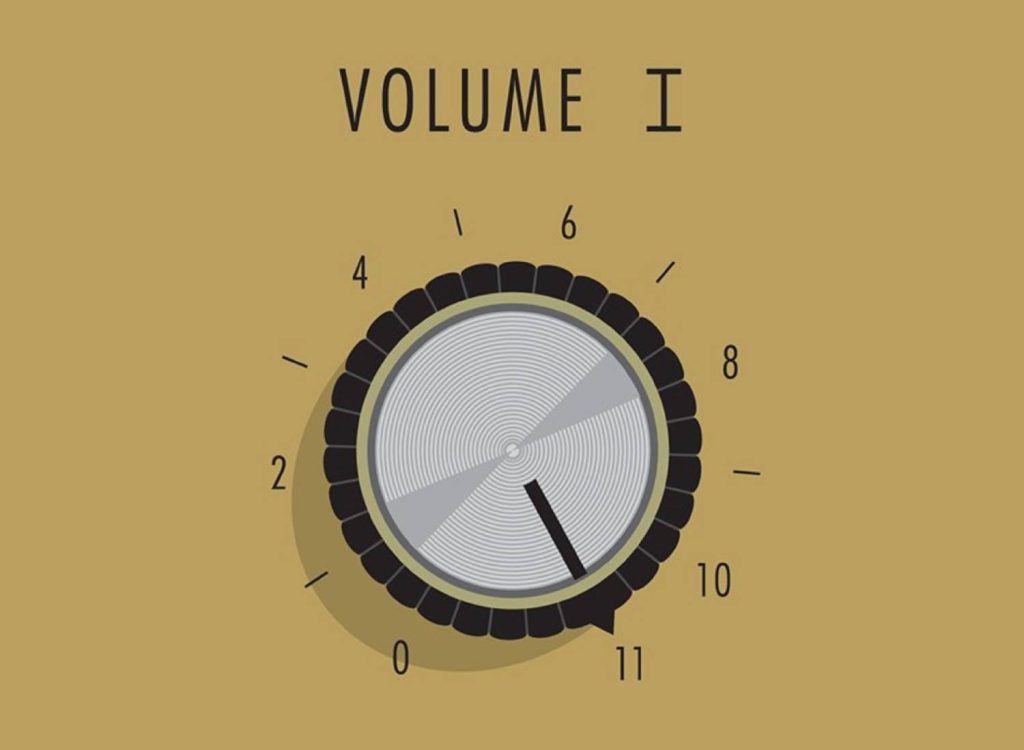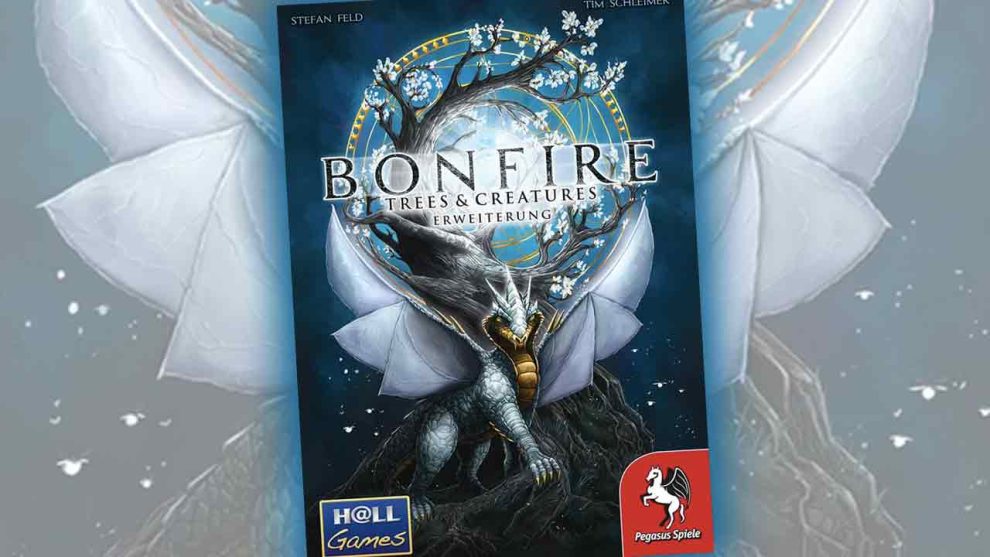Hello and welcome to ‘Focused on Feld’. In this series of reviews, I am working my way backwards through Stefan Feld’s entire catalogue. Over the years, I have hunted down and collected every title he has ever put out. Needless to say, I’m a fan of his work. I’m such a fan, in fact, that when I noticed that there were no active Stefan Feld fan groups active on Facebook, I created one of my own.
Today we’re going to talk about Bonfire: Trees & Creatures, the much anticipated expansion for 2020’s Bonfire, his 30th game.
This expansion includes three modules that can be added together or used separately, rules and components for adding a fifth player, as well as some stickers you can apply to your wooden components to liven them up a bit. I’m not going to spend any time on the fifth player components or stickers other than to say they’re there. Nor am I going to spend any time explaining how the base game is played. This review assumes you already know. If not, you can check out my review of the base game here.
Instead, we’re going to explore the new modules and discuss how they work and what I think about them. It is also my fervent hope that I’ll be able to answer that question you’ve asked yourself that, no doubt, led you here: is this an expansion that I need in my collection?
Module 1: Creatures
This module introduces nine Creature tiles to Bonfire. At the beginning of the game, a number of these equal to the player count plus two are drawn from the deck and presented to the players. Then, in reverse turn order, each player selects one of them to take into their possession for the remainder of the game. The remaining Creature tiles are returned to the box.

Each Creature has some unique benefit that it imparts to the player that owns it. For instance, the Cuddle Cat allows the player that owns it to score their Elder cards at the end of the game instead of scoring them immediately, while the Enchanted Spider allows the player that owns it to place any of their Fate tiles whenever they would place them (as opposed to having to select from just the top or bottom).
Thoughts About Creatures
I began with the Creatures module because not only is it the easiest of the three modules to incorporate, but it is also (in my opinion) the most powerful. The Creatures module effectively turns Bonfire into a game featuring asymmetric powers. And, wow, are they powerful. They fundamentally change the way that each player approaches the game.

For example, let’s consider the Great Turtle. This tile allows you to move any number of spaces whenever you use the ‘Move Your Ship’ action. Normally, in order to gain this amount of utility from that action, you’d need to spend three ship action tiles. Now, you accomplish the same feat using only one. And if you happen to have those other two ship tiles? Well, because of the game’s built-in 2:1 trade, you can utilize those other two tiles as a stand-in for something else. Or you could save those two tiles for two more chances to go anywhere you please. Have a few guardian action tiles to go along with those ships? Now, you can collect those guardians at a discount in a fraction of the time it would take you otherwise.
And that’s just one example. The other eight Creature tiles are just as powerful in their own rights.
Module 2: Events
The Event module introduces special effects into the game. The Event cards are shuffled into a face-down deck during setup. Before the first player takes their first turn, one of these cards is turned face up and its effect will remain in place until a new Event card replaces it. A new Event card is revealed to replace the current one anytime the first player is about to take the ‘place a fate tile’ action.

Each Event comes with some beneficial, game-changing effect that is available to every player. One will allow players to gain a task from an island without having to pay the associated cost of their Offering tile. Another allows them to take a gold whenever they retrieve a guardian from an island. Still another gains players two points whenever they recruit an elder.
These are just a few examples. In all, there are twenty-one Event cards to choose from.
Thoughts About Events
The Events module is also very powerful so long as a player is in a position to capitalize on it whenever the event is revealed. That’s much easier said than done, however. Since the Events are entirely random in nature, it’s nigh impossible to set yourself up for whatever’s going to come next. That being said, these Events hang around long enough that there are very few times that you won’t be able to capitalize on whichever Event is currently revealed at least once. But that does happen.

One such occasion occurred during one of the first games that I played with this module. The very first Event card that was revealed (card #4) allowed players to gain two points for each connected group of three or four identical symbols created by placing a Fate tile. Since it was the Event card placed before the first player’s first turn, it meant there was absolutely no way that they could capitalize upon it. Their one and only Fate tile had been placed during setup and there are no Fate tiles that feature multiples of the same symbols.
And while it might seem that this would affect every other player equally, bear in mind that this Event doesn’t change until the first player goes to place another Fate tile. It is entirely possible for the other players to burn through their action tiles at an accelerated rate in order to place multiple Fate tiles so they could take advantage of the Event. The First player, on the other hand, could never do this.
There are a few Event cards that fall victim to this conundrum. This could have been avoided with a slight tweak to the wording of the setup instructions for the module. Instead of “The Starting Player reveals the top Event before their very first turn and places it so everyone can see it.”, the wording should have been “The Starting Player reveals the top Event between steps 7 and 8 of the base game setup”; step 8 is the step in which the initial Fate tile placement is carried out. This would allow the starting player the opportunity to capitalize on any “comes into play” effects presented on the randomly selected Event card.
While this module is a really strong one, this issue definitely makes it not as powerful as it could be.
Module 3: Trees
Compared to the setup for the other modules, the setup for the Trees module is much more complex. And the actual mechanics are much more involved as well. That’s why I saved this module for last.
The Trees module consists of several components: a Tree board, twenty-four Tree tiles, six Guardian tiles, one neutral novice, one elder card, and three new Task tiles.
During setup: The Tree board is placed so that it abuts the lower edge of the base game’s board. The Tree tiles are shuffled and placed face up on the leftmost space before being dispersed among the other four spaces. The Guardian tiles are shuffled and four are randomly chosen and placed during setup. The neutral novice is placed onto the high council seat on the Tree board. The elder card joins the other six elders. Lastly, the Task tiles are shuffled together with the others.

Each time a player performs a guardian procession and at least one of those guardians ends its movement on a Path tile that doesn’t have a Tree next to it, that player may take a tree from one of the three leftmost trees. In order to do that, they first have to pay the cost shown on the Tree tile tile they’re wanting to take. That tree is then placed above any of that player’s Path tiles that have a guardian on them, but doesn’t already have a Tree tile. Then the remaining Tree tiles shift to fill in the empty spaces with a new one being drawn from the deck to fill in the fourth spot.
Each Tree tile has a color, a cost, and an effect. Trees placed next to bonfires of a matching color will earn extra points at the end of the game, but this is not a requirement. The cost will always be some combination of resources. And the effect will come in one of three flavors: an instant effect, an ongoing effect, or an end-game scoring effect.

In addition to the Trees themselves, the act of placing a Tree can earn the player bonuses depending on which guardians they have collected (if any). Each guardian color has an associated bonus depicted on the Guardian tiles that were placed during setup. So, for instance, if you took a Tree and had a neutral, blue, and pink guardian in your playing area, then you would also gain their associated benefits. But you would not receive the benefits of the grey guardian.
And, as if that weren’t enough, the Tree board also contains a new Common Task—have seven trees—and a new high council seat that allows the player placing a novice upon it to receive a free Tree tile of their choice or a victory point.
Thoughts About Trees
This is a fantastic module, but there’s definitely a lot more to internalize than the previous two. For instance, there are some white trees and those have some additional rules surrounding them which I didn’t even mention. It’s also very easy to forget to take a tree when you’re moving your guardians around during your first few plays with this expansion.
It’s also worth mentioning that out of the three modules, Trees is going to add the most time to your overall gameplay. This becomes exponentially more apparent as you add more players. Each Tree tile added requires you to not only have to weigh your three options (or even more options if you’ve got the right Guardian tile in play) to decide which Tree tile to take, but it also requires you to remember, and execute, any bonuses you may receive from the Guardian tiles.
Closing Thoughts
Each of the modules in this expansion are very well-designed (aside from the few issues I have mentioned previously) and they’re all very capable of standing up on their own. Taken altogether, they are a powerhouse trio that drastically changes the way that Bonfire is played. This expansion takes Bonfire, which was already a ten, and cranks it up to eleven.

I have almost nothing but praise for Trees & Creatures taken as a whole. In fact, the only gripe I have about it is less about what’s in the expansion than it is about something that’s not.
Amongst the printed material accompanying the expansion is an Appendix that goes into detail about what the iconography on all the new bits and pieces means (and, good lord, is there a lot of it). This is great! I’ve complained in the past about games that should have removable appendices but don’t (like my review of the Bonfire base game, for instance). So, I was thrilled when I found out that this expansion had such a thing. But why stop at just the expansion material? Why not add another page for the base game material which so desperately needs an appendix? This just seems like a huge, missed opportunity on the publisher’s part. Had this appendix contained the information about the base game as well, this expansion would have blown past eleven. It would have been ‘chef’s kiss’. If there’s ever a second edition of this expansion, it is my fervent hope that Pegasus Spiele reads this and keeps my suggestion in mind.
As to the question posed earlier—is this an expansion you need in your collection?—the answer is a resounding: it depends. There’s nothing wrong with Bonfire, you see. So, there’s nothing that needs fixing. Trees & Creatures isn’t one of those types of expansions. It’s one of those expansions that seeks to elevate an already enjoyable experience and it succeeds in this endeavor very well. But, there’s nothing about this expansion that you couldn’t live without.
However, Trees & Creatures is a heck of a lot of fun. I’ve thoroughly enjoyed every moment spent with it. It’s very easy to incorporate into the base game experience. Add to that the fact that all of the expansion components fit comfortably into the base game box and you’ll understand why Bonfire: Trees & Creatures is an expansion that I will never play without.
Do you need it? Probably not. Do you want it? Most definitely. It’s a purchase you won’t regret.












Add Comment